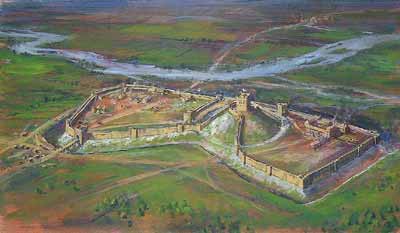Born: about 1045
Married: 1st Gladys (Gwaladus)
daughter
of (Verch) Rhiwallon ap Conwyn, Prince of North Wales (?Iorwerth
Drwyndwn) and x
2nd Beatrix
Acceded to Keeper of the Forests: 1100
Died: before1116 |
Notes: Some sources show he married Beatrice and some Gladys daughter
of the Prince of North Wales. Listed in the Domesday Book 1087. Fitzother
was not Constable of Windsor Castle as Windsor was a royal forest until
1066 when William I started construction of Windsor Castle. At the time
of the Survey in 1086, Walter Fitzother held a compact group of manors
as tenant-in-chief of the King in the counties of Berkshire, Buckinghamshire,
Hampshire, Middlesex, and Surrey. He also held Winchfield in Hampshire
from Chertsey Abbey and a royal manor and some woodlands at Windsor. The
transfer of Pembroke Castle to Gerald de Windsor indicates that both William
and Gerald were sons by Gladys. |
| Walter and Gladys had issue:
(Wi27) William Fitzwalter de Windsor b c 1070 d c 1160
(Wi27-2) Gerald de Windsor b c 1070 d by 1136
(Constable of Pembroke Castle) married Princess Nest(a) Verch Rhys of Deheubarth,
illegitimate daughter of Henry I.
Children by Beatrice:
(Wi27-3) Robert Fitzwalter of Little Easton
(Wi27-4) Maurice Fitzwalter
(Wi27-5) Reginald Fitzwalter
 |
The sources indicate that Walter was the first in the line to assume
the name Windsor, although construction of the castle itself was not begun
until he was already a man and only finished in the original version near
the end of his life.
Walter was a knight in the King's private retinue, and, when in 1070
William began the building of Windsor Castle, Walter was put in charge
of its defense, and later became the first Constable of Windsor. Under
the Norman kings, as with the kings of France, the Constable was the principal
officer of the royal establishment, and was responsible for the defense
of the establishment, by the knights stationed there. It was this position
that conferred the name 'Windsor' upon his sons. Above is an artist impression
of the appearance of the original Windsor Castle.
Windsor was built by William to control the middle reaches of the River
Thames, and together with other castles, each a day's march apart, to keep
open the route from London to the south coast, and thence to Normandy.
Since Walter was a young man in 1070, to have been given such responsibility,
shows the great respect felt for him by William.
Soon after 1070, Walter also had the important post of Warden of the
King's forests in Berkshire. Although generally associated with hunting,
the main recreation of the Royal household, the position was a military
one, since the forests were subject to regular patrolling, as a precaution
against enemies of the King. They were also regarded as the main source
of provender for armies on the move, or those stationed at strategic castles.
|
Source: Monograph of the Winsor Family
| 9 |
Dom. Bk. (Rec. Com.), i. 130a. |
| 10 |
The Colne and its branches and their respective mills in 1641 and 1725
are shown in B.M. Maps 1027, c. 30 and ibid. 1240 (53, 55); see also p.
33. |
| 11 |
For references to mills not identified or discussed below, see e.g.
C.P. 25(1)/149/52/329; /151/71/462; /151/81/151; C.P. 25(2)/27/178/12;
/692/3 Chas. II Trin. For 'atte Mills' see, e.g. Feet of F. Lond. and
Mdx. ed. Hardy and Page, i. |
| 12 |
S.C. 12/3/16. |
| 13 |
B.M. Add. MS. 20216, ff. 4d. 11. |
| 14 |
Hist. MSS. Com. 13th Rep. pt. 5, Ho. of Lords, 498. |
| 15 |
C 133/89/5; C 139/10/8; C.P. 25(1)/152/98/76. |
| 16 |
C 66/1967. |
| 17 |
M.R.O., Acc. 249/820-1, 826, 829. |
| 18 |
For its descent in the 17th and 18th cents., see M.R.O., Acc. 27/2
and Acc. 132/125. |
| 19 |
Middleton, View of Agric. of Mdx. 438; M.R.O., Acc. 132/113,
137, 166; L.T.A. Mdx. 6691; Shorter, Paper Mills and Paper Makers in
Eng. 1495-1800 (Paper Publics. Soc. vi), 214-15. |
| 20 |
M.R.O., L.T.A. Mdx. 6700; see above, p. 39. |
| 21 |
Guildhall MS. 9580/3, 20 June 1807; M.R.O. Stanwell Tithe Award. |
| 22 |
Kelly's Dir. Mdx. (1890); see also p. 49. |
| 23 |
Ibid. (1890-1937). |
| 24 |
Personal observation. |
| 25 |
See extents of manor cited above, p. 36, n. 97-98. |
| 26 |
Year Bk. 17 & 18 Ed. III (Rolls Ser.), p. 209; B.M.
Add. MS. 20216, f. 13. |
| 27 |
Cal. Close, 1461-8, p. 367. |
| 28 |
C 142/253/69. |
| 29 |
Public Works in Medieval Law, ii (Selden Soc. xl), 48. |
| 30 |
C.P. 25(1)/151/79/105; Cal. Close, 1468-76, 228. |
| 31 |
Cal. Pat. 1554-5, 296; E 123/23, f. 143. |
| 32 |
Cal. S.P. Dom. 1611-18, 111. |
| 33 |
Bodl. MS. Don c. 26. |
| 34 |
B.M. Map 3465(4). |
| 35 |
See docts. cited on p. 37, nn. 34, 36, and Shorter,
Paper Mills,
215. |
| 36 |
M.R.O., L.T.A. Mdx. 6681; see also ibid. F 34/248. |
| 37 |
E 134/1652 East. 6, m. 3; C.P. 25(2)/574/1651 Mich. |
| 38 |
M.R.O., Acc. 249/821, 827, 829. |
| 39 |
M.R.O., L.T.A. Mdx. 6691-6727. |
| 40 |
Ibid.; Stanwell Tithe Award; Kelly's Dir. Mdx. (1866-1906). |
| 41 |
Personal observation and information from the staff. |
| 42 |
M.R.O., L.T.A. Mdx. 6681. |
| 43 |
M.R.O., Stanwell Tithe Award. |
| 44 |
Ibid.; Kelly's Dir. Mdx. (1886-94). |
| 45 |
Kelly's Dir. Mdx. (1866); O.S. Map 1/2,500 Mdx. xix. 7 (2nd
edn.). |
| 46 |
M.R.O., L.T.A. Mdx. 6694. |
| 47 |
Ibid. 6719-27; Stanwell Tithe Award. |
| 48 |
Personal observation and information from Mrs. Wooster, Stanwellmoor. |
/ol>
